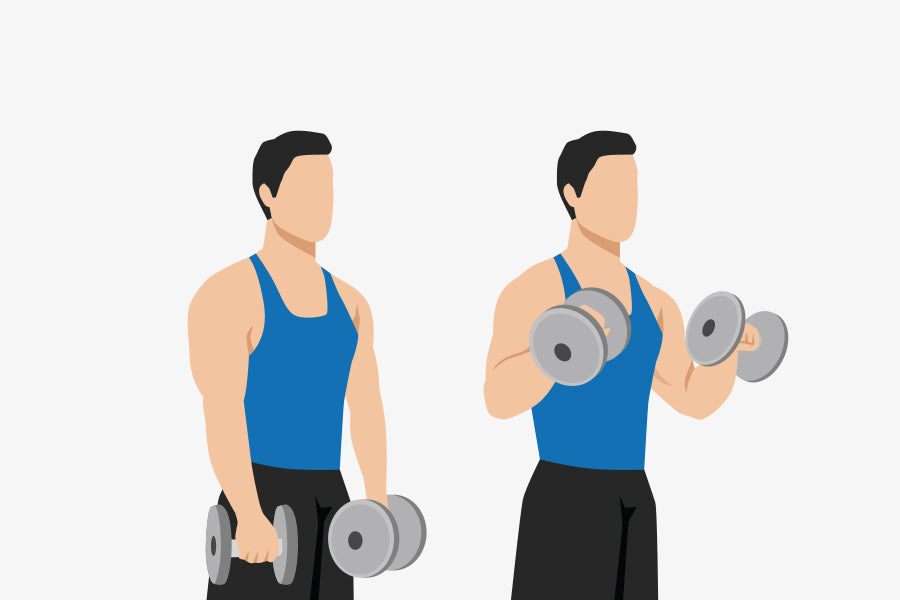We've all seen those impressive reverse curls that make even the most seasoned fitness enthusiasts stop and watch in amazement. But what are they? How do you do them? And more importantly, can you do them wrong?
But before we dig deep into the nitty gritty, let's first take a closer look at reverse curls and why they're so beneficial. Stay tuned for more tips and guides on how to perfect your reverse curl technique, as well as benefits and mistakes to avoid.
Related Article: Bulking Vs. Cutting: Best Way to Build Muscle
What are Reverse Curls?
Reverse curls are a type of exercise that helps build the muscles in your upper arms. Unlike regular curls, which involve a supinated (palms up) grip, reverse curls involve a pronated (palms down) grip.
This motion stresses the muscles in your outer arms, which can help build strength and definition. Reverse curls can be done with dumbbells, barbells, or resistance bands. To do it:
- Start by standing with your back straight with the shoulder back, and chest lifted.
- Grab a set of dumbbells with your palms facing downwards (pronated grip) and rest the dumbbells on the front of your thighs.
- Inhale and bend your elbows to move the weights toward your shoulders.
- Lift the dumbbells till you feel a complete bicep contraction.
- Lower the weights to the starting position slowly with control and exhale as you resume the exercise.
What Muscles Do Reverse Curls Work?
Building muscle isn't all about hulking biceps and chiseled pecs. Some of the most impressive muscles are the ones you can't see.
Take, for example, the forearm. This often-overlooked muscle group is responsible for everything from opening jars to playing the piano. And when it comes to building mass, reverse curls are one of the best exercises you can do.
This movement targets both the forearms and the biceps, making it an ideal exercise for those looking to add some serious size.
The reverse curl is your ticket to sculpting a strong, defined set of upper arms. With each rep, you're targeting- the show-stopping biceps and its understudy brachialis. You may not be able to see it, but this important muscle serves as an essential bridge between the arm bone and forearm for smooth joint movement.
Plus, using a reverse grip can also work your grip strength, which is essential for any lifter.
Related Article: How to Stretch IT Band: 11 Best Stretches for Improving Your Flexibility
Variations of Reverse Curls
To make the exercise challenging and efficient, try these variations.
Reverse Barbell Curl

The reverse barbell curl is an amazing way to build strength and size in the biceps. However, it's important to use proper form to get the most out of the exercise.
To do it:
- Stand with your back straight and your feet together.
- Hold the barbell with your hands about shoulder-width apart and your palms facing down.
- Lower the bar by your thighs with your arms extended and the elbows close to your sides.
- Keep a comfortable posture and your gaze in front.
- Curl the barbell up and squeeze with your wrists straight. Don’t rest at the top.
- Then, lower the bar back down but don't fully extend your arms.
- Make sure to keep your elbows at your sides and your palms facing down throughout the entire range of motion.
- If you start to swing the weight or let your elbows flare out, you'll put unnecessary stress on your joints, and you won't be able to work your biceps as effectively.
Reverse Curl With EZ Bar

The reverse curl with the EZ bar is an effective exercise for building the forearm muscles. To do it:
- Load the EZ bar with an appropriate weight.
- Then, stand with your feet hip-width apart, and hold the bar with the shoulder-width overhand (ideally thumbless) pronated grip.
- Keep your elbows in and bring the EZ bar to your chest by bending your elbow.
- Feel the contraction for a moment and lower the bar down to the arms’ extended position
- Repeat the reps.
- The key to this exercise is to keep the elbows close to the body and to focus on contracting the muscles of the forearm.
- For best results, perform three sets of 10-12 repetitions.
Preacher Reverse Curl With EZ Bar

The preacher reverse curl with the EZ bar is a great exercise for targeting the biceps.
To do it:
- Set up the EZ bar reverse grip preacher curl by adjusting the seat height so that the back of your upper arms rests flat on the pads.
- Load the bar with the required weight and sit on the bench.
- Grip the bar with an overhand grip (palms facing down).
- Keep your arms fixed and only bend them at the elbows.
- Curl the bar till your arms are perpendicular to the ground.
- Without pausing, slowly lower the bar back to the starting position.
- Repeat the reps.
The key to this exercise is to keep the upper arms perpendicular to the ground. This ensures that all of the force is directed through the biceps rather than absorbed by the shoulder joints. As a result, the biceps are placed under maximum tension, making them grow faster.
Related Article: How to Do a Renegade Row: Benefits, Variations, & Common Mistakes
Benefits of Doing Reverse Curls
Adding reverse biceps curls to your workout regimen can be beneficial in many ways. They will help you lift heavy weights during standard curl exercises and correct any muscle imbalances between flexors and extensors. With a pronated grip, activating those muscles is easier than ever before.
It's not just for fitness — this exercise could also prove valuable after an injury: it plays a key role in rehabilitating injured biceps three months post-injury. And it doesn't stop at that; activities such as vacuuming around the house become simpler with stronger arms too.
Related Article: 10 Advanced Exercises to Take Your Arms to the Next Level
How to Work Out Safely & Avoid Injury
While the reverse curl exercise is an amazing way to tone your arms, a few common mistakes can sabotage your results.
- First, make sure that you're using the right weight. If the weight is too less, you won't get the full benefit of the exercise.
- On the other hand, if the weight is excessively heavy, you may strain your muscles.
- Second, keep your elbows close to your body throughout the exercise. This will help to target the right muscles and prevent injury.
- Finally, be sure to use a full range of motion. When your arms are fully extended, your muscles are under the most stress and will benefit most from the exercise.
If you've got any injury in those areas, it's best to avoid this exercise altogether. Or, if you're feeling particularly daring, you can consult your doctor about whether the reverse curl is safe, given your condition.
If you experience harsh pain or discomfort during the reverse curl, discontinue the exercise. When starting, be sure to use a weight that you can lift 8 to 12 times with the correct form. From there, work your way up to two to three sets of 8 to 12 reps. And that's all there is to it! Now get out there and start curling.
By avoiding these common mistakes, you can maximize the benefits of the reverse curl exercise and achieve optimal results.
FAQs
1. How to do a reverse dumbbell wrist curl over a bench?
- Grip a pair of dumbbells using a reverse grip (palms facing down) and kneel in front of a bench.
- Rest the back of your forearms on the bench so your wrists are off the end.
- Bending only at the wrists, let the dumbbells drop as far as possible (starting position).
- Raise the dumbbells slowly as far as possible and squeeze the forearm muscles at the top of the movement.
- After a pause, slowly lower the dumbbells back to the starting position.
- Repeat the reps.
2. How are reverse curls effective for forearms?
This exercise targets the brachioradialis, a muscle that extends from the elbow to the shoulder. Unlike traditional bicep curls, which primarily work the biceps brachii, reverse curls place more emphasis on the brachioradialis. As a result, you can achieve greater definition in your forearms.
3. What is a reverse barbell curl?
The reverse barbell curl is an effective way of building muscle and strength. It helps double the size of your biceps.
- Stand with your back straight and your feet together.
- Hold the barbell with your hands about shoulder-width apart and your palms facing down.
- Lower the bar by your thighs with your arms extended and the elbows close to your sides.
- Take a comfortable posture and keep your gaze in front.
- Curl the barbell up and squeeze with your wrists straight. Don’t rest at the top.
- Then, lower the bar back down but don't fully extend your arms.
4. What are reverse curls?
Reverse curls, are a great exercise for targeting the biceps. Reverse curls help build strength in the biceps and can be easily incorporated into any arm workout routine.
The Bottom Line
So, there you have it — all you need to know about reverse curls and how to make the most of this exercise. Remember to keep your form in check, use a pronated grip, and mix things up with variations to achieve optimal results. With regular practice, you'll see a marked improvement in the strength and definition of your upper arms in no time.
Reading List
Article Sources
- Marcolin, Giuseppe, et al. ‘Differences in Electromyographic Activity of Biceps Brachii and Brachioradialis While Performing Three Variants of Curl’. PeerJ, vol. 6, July 2018, p. e5165. PubMed Central, https://doi.org/10.7717/peerj.5165.
- Kostek, Mark T., and Karen Knortz. ‘Kinesiology Corner: The Bicep Curl and the Reverse Bicep Curl’. Strength & Conditioning Journal, vol. 2, no. 6, Dec. 1980, pp. 55–55. journals.lww.com, https://journals.lww.com/nsca-scj/Citation/1980/12000/Kinesiology_Corner__The_Bicep_Curl_and_the_Reverse.10.aspx.








